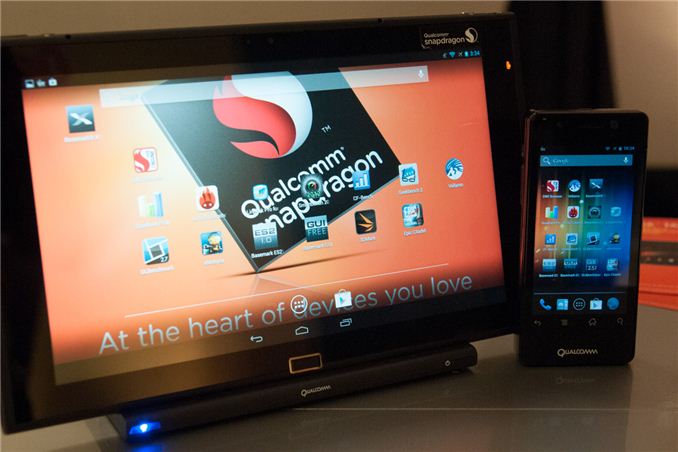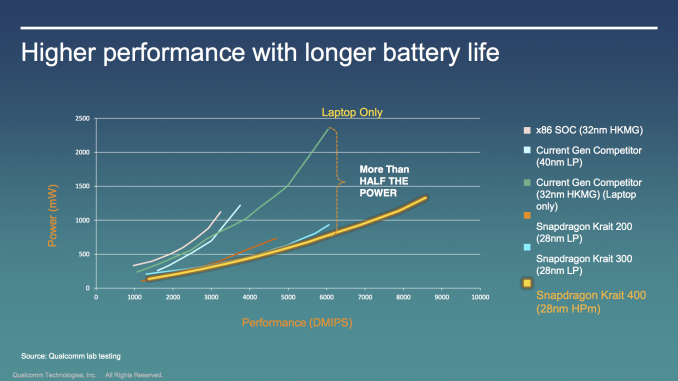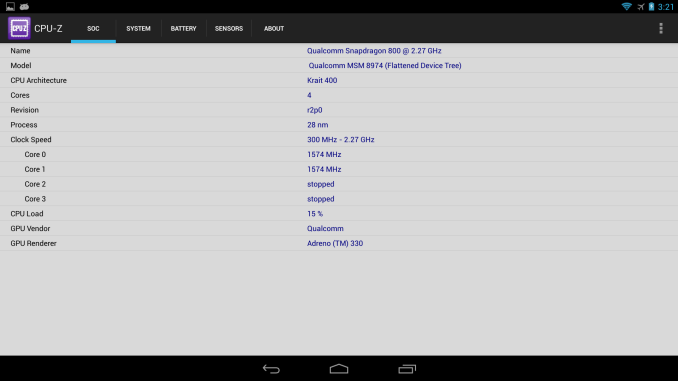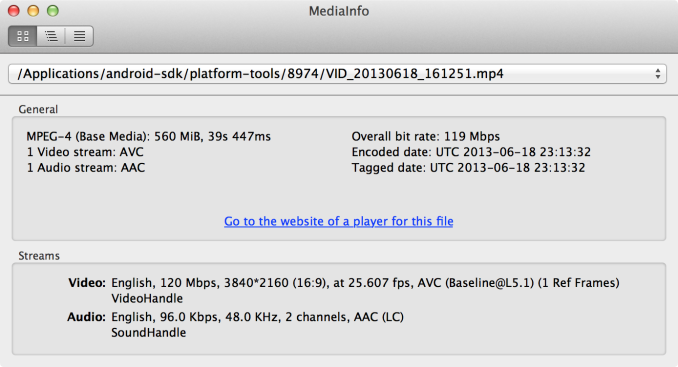Snapdragon 800 (MSM8974) Performance Preview: Qualcomm Mobile Development Tablet Tested
by Brian Klug on June 18, 2013 8:00 PM EST
We’ve written about Snapdragon 800 (MSM8974) before, for those unfamiliar, this is Qualcomm’s new flagship SoC with four Krait 400 CPUs at up to 2.3 GHz, Adreno 330 graphics, and the latest modem IP block with Category 4 LTE. Qualcomm is finally ready to show off MSM8974 performance on final silicon and board support software, and invited us and a few other publications out to San Francisco for a day of benchmarking and poking around. We looked at MSM8974 on both the familiar MSM8974 MDP/T, a development tablet used both by Qualcomm and 3rd parties to develop drivers and platform support, and the MSM8974 MDP phone, both of which have been publicly announced for some time now.
The tablet MDP is what you’d expect, an engineering platform designed for Qualcomm and other third parties to use while developing software support for features. Subjectively it’s thinner and more svelte than the APQ8064 MDP/T we saw last year, but as always OEMs will have the final control over industrial design and what features they choose to expose. Display is 1080p on the tablet and 720p on the phone, a bit low considering the resolutions handset and tablet markers are going for (at least 1080p on phone and WQXGA on tablets) so keep that in mind when looking at on-screen results from benchmarks.
| Qualcomm Snapdragon 800 Mobile Development Platform Tablet | |
| MSM8974 MDP/T | |
| SoC | MSM8974 Snapdragon 800 |
| CPU | 4x Krait 400 at 2.3 GHz |
| GPU | Adreno 330 at 450 MHz |
| RAM | 2GB 2x32 LPDDR3 800 MHz |
| NAND | 32 GB eMMC 4.5 |
| Cameras | 12 MP with flash (rear), 2 MP (front) |
| Display | 11.6-inch 1080p |
| I/O | USB 3.0, microHDMI, microSD, 3.5mm headset |
| OS | Android 4.2 |
Snapdragon 800, nee MSM8974 is built on TSMC’s 28nm HPM (High Performance for Mobile) HK-MG, as opposed to 28nm LP polysilicon (low power). The result are higher clocks for CPU, from 1.5–1.7 GHz on Krait 200–300 which was 28nm LP, to 2.2–2.3 GHz on Krait 400 on 28nm HPM. The jump between Krait 200 and Krait 300 brought higher clocks and also a jump in IPC, this time around Krait 400 is essentially a Krait 300 implemented on 28nm HPM, which means some relayout. There’s also a faster L2 cache on Krait 400.
These are final clocks on MSM8974 – Krait 400 runs its four cores at up to 2.3 GHz, though some lots will come at 2.2 GHz. GPU on MSM8974 is Adreno 330 which runs at 450 MHz and brings some architectural improvements over Adreno 320.
On the video side, MSM8974 is capable of encoding UHD 4K (3840 x 2160) 30 FPS video at up to 120 Mbps H.264 High Profile, and is capable of playing back the same file. Qualcomm had a demo going showing this mirrored on the latest Sony 4K UHD TV as well over microHDMI. I recorded a video sample and took a copy for your perusal and onto YouTube. True to their word the video I grabbed is 120 Mbps and 3840 x 2160, framerate was just over 25 FPS but I'm not sure if the demo was setup for 30 FPS capture. MSM8974 has the hardware encoder for H.264 but not HEVC H.265, that's implemented in software.
Snapdragon 800 should begin popping up in phones and tablets fall 2013. Anyhow let's take a look at MSM8974 performance.

























115 Comments
View All Comments
Bob Todd - Wednesday, June 19, 2013 - link
That would be awesome, but I highly doubt it. Unless they radically change their target market for that device, I don't think you'll see a bleeding edge SOC or super high resolution display. It was meant to win back the market share lost to the likes of the budget friendly Kindle/Nook tablets who were eating Google's lunch in the tablet market while using their OS at the core. I just don't see a Snapdragon 800 in a ~$200 device, for the same reasons you don't see Swift or Retina displays in the iPad Mini. I think we're much more likely to see an S4 Pro quad/Adreno 320 (possibly Snapdragon 600?). Even that would be a hell of an upgrade to the existing Tegra 3, and I'd happily throw my Nexus 7 up on eBay for that. Admittedly, I may end up with an x86 Windows 8.1 tablet with Silvermont or Temesh instead of the next Nexus 7 anyway.Krysto - Wednesday, June 19, 2013 - link
"Snapdragon 800 can definitely be quicker than ARM's Cortex A15"What does that sentence even mean? You're comparing 2.3 Ghz Krait 400 vs 1.7 Ghz Cortex A15.
aryonoco - Wednesday, June 19, 2013 - link
He's comparing what he has (Snapdragon development tablet) with other things that he has.Clock frequency is pointless to compare by itself. Sure A15 might be faster clock-for-clock, but it's also more power hungry so you won't be seeing it hit 2.0 Ghz anytime soon. Looks like a Snapdragon 800 can easily clock higher which more than compensates its IPC disadvantage compared to A15 while keeping power usage in check.
Qualcomm is sitting very comfortable right now. No wonder their market cap is now bigger than Intel, while they have a fraction of Intel's revenue/profits. The market clearly likes what they see from them.
Wilco1 - Wednesday, June 19, 2013 - link
A15 is already at 1.9GHz with Tegra 4. If A15 was built on 28nm HPM then it would also reach 2.3-2.5GHz. I bet we'll get something like that this year.Note there is no evidence A15 uses more power. In S4 tests it seems the Exynos Octa has lower power consumption than Krait.
Wilco1 - Wednesday, June 19, 2013 - link
Just came across this: http://arstechnica.com/gadgets/2013/06/qualcomms-s...Looks like Tegra 4 still beats it at 1.9GHz. And good to see some tech sites showing native benchmarks.
xinthius - Wednesday, June 19, 2013 - link
That isn't the impression I got from the article. CPU wise Tegra 4 edges it, but on the off-screen GPU tests Adreno has a solid lead.Wilco1 - Wednesday, June 19, 2013 - link
Tegra 4 finally has a fast GPU - nobody has benchmarked it yet but the one available score (Egypt HD at 57fps) suggests it will be a close match with Adreno.sherlockwing - Wednesday, June 19, 2013 - link
Tegra 4 is already A15 on HPM and it is capped at 1.9Ghz, no evidence on how much further it can be pushed. Also Exynos Octa have 4 A7s to reduce power consumption, in GSMArena's benches it still fall behind S600 in battery life.Wilco1 - Wednesday, June 19, 2013 - link
Anand says it is LPM (unlike Tegra 4i, which is HPM): http://www.anandtech.com/show/6550/more-details-on...The Exynos variant of S4 does indeed fall behind in battery life in the GSMArena test, but that was on talk time and video playback, ie. not related at all to the CPU. QC has a big lead in low-power modems and it shows. Browsing was within 6%, so that confirms that the A15 uses similar power as Krait to get slightly better performance. I'm still hoping Anand will do a full review...
aryonoco - Wednesday, June 19, 2013 - link
Yes, the architecture comparison between A15 and Krait 400 and next-gen Swift will be very interesting.Add in Bay Trail and Temash and we CPU enthusiasts are really experiencing a golden age. When was the last time we had so many different competing designs and architectures? When you compare the progress from Scorpion to Krait 200 to Krait 400 (or A9 to A15) in a matter of 2 years... the pace of development in the mobile world is astonishing.
I'm also relying on Anand to do some full analysis and review of all these architectures once they become available. It's pretty clear that Tegra 4 is going to be cheaper than Snapdragon 800, it would be great to see them side by side, with power analysis and all.